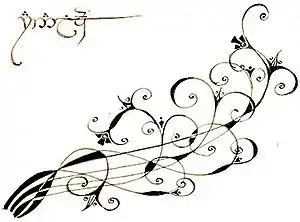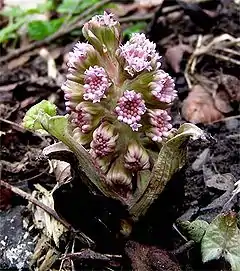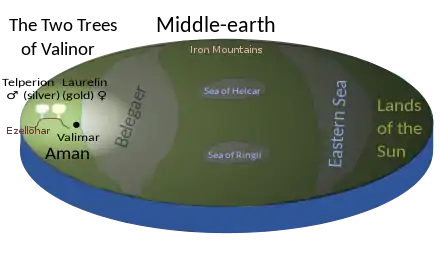Plants in Middle-earth
The plants in Middle-earth, the fictional world devised by J. R. R. Tolkien, are a mixture of real plant species with fictional ones. Middle-earth was intended to represent the real world in an imagined past, and in many respects its natural history is realistic.

The botany and ecology of Middle-earth are described in sufficient detail for botanists to have identified its plant communities, ranging from Arctic tundra to hot deserts, with many named plant species, both wild and cultivated.
Scholars such as Walter S. Judd, Dinah Hazell, Tom Shippey, and Matthew T. Dickerson have noted that Tolkien described fictional plants for reasons including his own interest in plants and scenery, to enrich his descriptions of an area with beauty and emotion, to fulfil specific plot needs, to characterise the peoples of Middle-earth, and to establish tangible symbols in his mythology.
Context

J. R. R. Tolkien intended Middle-earth to represent the real world in an imagined past, thousands of years before the present time.[T 1] He made clear the correspondences in latitude between Europe and Middle-earth, establishing the presence of both British and Mediterranean zones:
The action of the story takes place in the North-west of 'Middle-earth', equivalent in latitude to the coastlands of Europe and the north shores of the Mediterranean. ... If Hobbiton and Rivendell are taken (as intended) to be at about the latitude of Oxford, then Minas Tirith, 600 miles south, is at about the latitude of Florence. The Mouths of Anduin and the ancient city of Pelargir are at about the latitude of ancient Troy.[T 2]
Tolkien learnt about plants, their history and cultivation from his mother, from his reading, from visiting show gardens, by gardening, and by studying medieval herbals, which taught him about the lore and supposed magical properties of certain plants.[2] He stated that the book that most influenced him as a teenager was C. A. Johns's Flowers of the Field, a flora of the British Isles, which he called his "most treasured volume".[1] He explained that he was intrigued by the diversity of plant forms, as he had a "special fascination ... in the variations and permutations of flowers that are the evident kin of those I know".[1][3] Among his artworks are a series of paintings of grasses and other plants, often with the names he gave them in Quenya, one of his invented Elvish languages.[4] These could be realistic or, as with his pencil and ink drawing of ranalinque or "moon-grass", stylized, in the manner of Art Nouveau.[1]
Literary functions
In his Middle-earth writings, Tolkien mentions real plant species, and introduces fictional ones, for a variety of reasons. Dinah Hazell describes the botany of Middle-earth as being "the best, most palpable example" of Tolkien's realistic subcreation of a secondary world. In her view, this at once serves a "narrative function, provides sense of place, and enlivens characterization", while studying the flora and their associated stories gives the reader a deeper appreciation of Tolkien's skill.[2] These purposes are described below.
Realism

Tolkien mentions many plants appropriate to the geographical and climatic zones through which his characters pass, especially in The Lord of the Rings, the accurate plant ecology conveying a strong sense of the reality of Middle-earth. Scholars such as Matthew Dickerson, Jonathan Evans, and Walter S. Judd with Graham Judd, have described the botany and ecology of Middle-earth in some detail, from the agriculture of the Shire[5] to the horticulture of the Elves,[6] the wildwood of the Ents,[7] and the polluted volcanic landscape of Mordor.[8] Walter and Graham Judd have examined the Middle-earth flora and its various plant communities from Arctic tundra to hot deserts,[9] have listed and illustrated the many identifiable plant species from alders to yews, not forgetting cultivated plants from beans to flax,[10] and have provided identification keys to the plants and flowering herbs involved.[11]
The Shire is described as a fertile agricultural region, able to produce not only the food needed by its comfortable population, complete with Gaffer Gamgee's "taters" (potatoes), but cultivated mushrooms, wine such as the delicious Old Winyards, and tobacco.[12] Nearby Bree indeed uses botanical names for many of its people, such as the "doubly botanical"[13] name of the innkeeper Barliman Butterbur, named for barley (the chief ingredient of beer), and the butterbur, a large stout wayside herb of Northwestern Europe. Other plant-based surnames in Bree include Ferny, Goatleaf, Heathertoes, Rushlight, Thistlewool, and Mugwort.[T 3][13]
Towards the end of their quest, Frodo and Sam travel through the Mediterranean vegetation of Ithilien, giving Tolkien the opportunity to demonstrate the "breadth of his botany" with convincing details of that region's mild climate and different flora.[12][T 4]
Narrative and plot
He threw the leaves into boiling water and bathed Frodo's shoulder. The fragrance of the steam was refreshing, and those that were unhurt felt their minds calmed and cleared. The herb had also some power over the wound, for Frodo felt the pain and also the sense of frozen cold lessen in his side;[T 5]
Some plants fulfil a specific plot need, such as with athelas, a healing plant that turns out to be the cure for the Black Breath, the chill and paralysis that overcame people who fought against the Ringwraiths, Sauron's most deadly servants. In The Lord of the Rings, Athelas is used only by Aragorn, who becomes King of Gondor, explaining its common name, Kingsfoil.[T 5][T 6] Shippey remarks that Aragorn the healer-king echoes a real English King, Edward the Confessor.[14] Tolkien may have had the Old English Herbarium in mind with the healing herb Kingsfoil: in that text, Kingspear (woodruff) is said to have a distinctive aroma, and to be useful for healing wounds, while the ending in -foil, meaning "leaf", is found in the names of herbs such as cinquefoil.[15]
Sense of place
One reason was to enrich his descriptions of an area with beauty and emotion, such as with the small white Niphredil flowers and the gigantic Mallorn trees with green and silver leaves in the Elvish stronghold of Lothlórien, symbolising indeed Galadriel's Elves.[16][T 7] Similarly, when describing the Island of Númenor, lost beneath the waves before the time of The Lord of the Rings, Tolkien introduces Oiolairë, an evergreen fragrant tree said to be highly esteemed by the people there.[T 8] Or again, when describing the grave-mounds of the Kings of Rohan, Tolkien mentions Simbelmynë (Old English for "Evermind"), a white Anemone that once grew in Gondolin and that stands for remembrance of the noble and brave Riders of Rohan.[16][T 9][17] David Galbraith of the Royal Botanical Gardens (Ontario) writes that "plants are ... crucial in imagined landscapes", and that few of these are as rich in detail as Tolkien's Middle-earth", where "the plants ranged from simple and familiar to exotic and fantastic".[18]
Characterisation
Tolkien mentions plant products, too, when he wishes to characterise a people. In the Prologue to The Lord of the Rings, he explains that "pipe-weed", tobacco, is derived from "a strain of the herb Nicotiana", and that the Hobbits of the Shire love to smoke it, unlike the other peoples of Middle-earth. He goes into some detail on this, naming the varieties Longbottom Leaf, Old Toby, and Southern Star, grown in the Shire, and Southlinch from Bree.[T 10][T 11] This has a personal ring, as Tolkien loved to smoke a pipe, and indeed described himself as a Hobbit: "I am in fact a Hobbit (in all but size). I like gardens, trees, and unmechanized farmlands; I smoke a pipe, ... I am fond of mushrooms (out of a field)".[19][20][T 12]
Obsessive interest
The scholar Patrick Curry states that "Tolkien obviously had a particular affection for flora", especially trees, noting that the birch was his "personal 'totem'".[21] Tom Shippey writes that Tolkien's many mentions of plants reveal a deep and continuous interest:
Through all his work moreover there runs an obsessive interest in plants and scenery, pipeweed and athelas, the crown of stonecrop round the overthrown king's head in Ithilien, the staffs of lebethron-wood with a "virtue" on them of finding and returning, given by Faramir to Sam and Frodo, the holly-tree outside Moria that marks the frontier of 'Hollin' as the White Horse of Uffington shows the boundary of the Mark [in England], and over all the closely visualised images of dells and dingles and Wellinghalls, hollow trees and clumps of bracken and bramble-coverts for the hobbits to creep into.[16]
Identity of man and nature
Shippey comments that Tolkien's strongest belief, visible as a theme in much of his writing, is the identify of man and nature; he gives multiple examples:
| Person or Group | Inseparable from or symbolised by |
|---|---|
| Tom Bombadil | Withywindle area (Old Forest) |
| Fangorn (Treebeard) | Fangorn Forest |
| Hobbits | The Shire |
| Riders of Rohan | Simbelmynë flowers |
| Elves of Lothlórien | Mallorn trees |
Mythic symbols

A final reason was to establish tangible symbols in his mythology. Early in the history of Arda, he introduced the Two Trees of Valinor, enormous magical trees that illuminated the Blessed Realm until their destruction by the first Dark Lord, Morgoth. However, some of the light of the Trees was saved in the Silmarils, central to the mythology of The Silmarillion.[T 13][T 14] In addition, another tree, Galathilion, was created in the image of one of the Two Trees, Telperion. One of its seedlings, named Celeborn, was brought to the island of Tol Eressëa. One of its seedlings was given to the Men of Númenor, and it became Nimloth, the White Tree of Númenor. It was destroyed by the King, Ar-Pharazôn, who had come under Sauron's influence; but the hero Isildur had saved one of its fruits, and when he arrived in Middle-earth from the wreck of Númenor, he planted its seeds; one of these grew into the White Tree of Gondor. When the line of Kings of Gondor failed, the White Tree died, and stood dead in the royal courtyard of the city of Minas Tirith throughout the centuries of rule by the Stewards of Gondor. When Aragorn returned as King, he fittingly found a seedling of the White Tree on the mountain behind the city.[T 15][22]
Stéphanie Loubechine describes the opposing roles of the beneficial birch and the malign willow in Tolkien's tree symbolism, on the view that plants are not simply a green backdrop but consistently carry meaning.[23] Curry comments however that Tolkien's trees are never just symbols, also being individuals in the narrative.[24]

In film
Peter Jackson's film trilogy of The Lord of the Rings set the action largely in the New Zealand landscape. The New Zealand ecologist Robert Vennell writes that this put native and introduced plant species into the films in "an important supporting role". He notes for instance that as Frodo and Sam set out on their quest across the Shire in The Fellowship of the Ring, they are "knee deep" in the invasive species wandering willie, Tradescantia fluminensis, a native of Latin America; it covers the ground, drowning out the native forest undergrowth. Further south, they travel through forests of southern Beech, Nothofagus, used for the Elvish forest of Lothlorien and the Entish forest of Fangorn.[25] Fictional flowers, too, were created for the films; Vennell writes that the wood anemone-like Simbelmynë of Rohan were made in the Weta Workshop.[26]
References
Primary
- This list identifies each item's location in Tolkien's writings.
- Carpenter 1981, Letter 183 notes on W. H. Auden's review of The Return of the King, 1956
- Carpenter 1981, Letter 294 to Charlotte and Denis Plimmer, 8 February 1967
- Tolkien, J. R. R. (1975). Lobdell, Jared (ed.). Guide to the Names in The Lord of the Rings. A Tolkien Compass. Open Court. pp. 155–201. ISBN 978-0875483030.
- The Two Towers, book 4, ch. 7 "Journey to the Cross-Roads"
- The Fellowship of the Ring, book 1, ch. 12 "Flight to the Ford"
- The Return of the King, book 5, ch. 8 "The Houses of Healing"
- The Fellowship of the Ring, book 2, ch. 6 "Lothlórien"
- Unfinished Tales, "A Description of the Island of Númenor"
- The Two Towers, book 3, ch. 6 "The King of the Golden Hall"
- The Lord of the Rings, "Prologue"
- The Return of the King, book 6, ch. 7 "Homeward Bound"
- Carpenter 1981, Letter 213 to Deborah Webster, 25 October 1958
- The Silmarillion, "Quenta Silmarillion", ch. 3 "Of the Coming of the Elves and the Captivity of Melkor"
- The Silmarillion, "Quenta Silmarillion", ch. 8 "Of the Darkening of Valinor"
- The Return of the King, book 6, ch. 5 "The Steward and the King"
Secondary
- McIlwaine 2018, p. 198.
- Hazell 2015, Introduction.
- Johns, Charles Alexander (1886). Flowers of the Field (24th ed.). Society for Promoting Christian Knowledge. OCLC 561798225.
- McIlwaine 2018, p. 184.
- Dickerson & Evans 2006, pp. 71-94.
- Dickerson & Evans 2006, pp. 95-118.
- Dickerson & Evans 2006, pp. 119-144.
- Dickerson & Evans 2006, pp. 185-214.
- Judd & Judd 2017, pp. 6-25.
- Judd & Judd 2017, pp. 73-346.
- Judd & Judd 2017, pp. 50-66.
- Curry 2013, pp. 512–513.
- Judd & Judd 2017, pp. 342-344.
- Shippey 2005, p. 206.
- Kisor 2013, p. 350.
- Shippey 2005, p. 150.
- Judd & Judd 2017, pp. 144-146.
- Galbraith, David (Head of Science) (22 April 2020). "Botanicult Fiction: The Flora of J.R.R. Tolkien's Middle Earth". Royal Botanical Gardens, Ontario. Retrieved 24 September 2020.
- Carpenter 1978, pp. 61, 81.
- Rogers, Evelyn (19 December 2013). "Check It Out: The hows and whys of Hobbits". The Los Angeles Times. Retrieved 9 September 2020.
- Curry 2000, p. 282.
- Dickerson 2013, pp. 678–679.
- Loubechine, Stéphanie "Le Saule et le Bouleau — Symbolique de l'arbre chez Tolkien" [The Birch and the Willow – Tolkien's Tree Symbolism] in Willis 2011, Chapter 1
- Curry 2000, p. 283.
- Vennell, Robert (15 May 2016). "Lord of the Trees: The Botany of Middle Earth". The Meaning of Trees. Retrieved 24 September 2020.
- Vennell, Robert (23 March 2019). "Lord of the Trees: The Botany of Middle Earth – Part II". The Meaning of Trees. Retrieved 24 September 2020.
Sources
- Carpenter, Humphrey (1978) [1977]. J. R. R. Tolkien: A Biography. G. Allen & Unwin. ISBN 978-0-04-928039-7.
- Carpenter, Humphrey, ed. (1981), The Letters of J. R. R. Tolkien, Boston: Houghton Mifflin, ISBN 0-395-31555-7
- Curry, Patrick (2013) [2007]. "Plants of Middle-earth". In Drout, Michael D. C. (ed.). J.R.R. Tolkien Encyclopedia. Routledge. pp. 512–513. ISBN 978-0-415-86511-1.
- Curry, Patrick (2000). Coupe, Laurence (ed.). Defending Middle-earth. The Green Studies Reader: From Romanticism to Ecocriticism. Psychology Press. pp. 282ff (chapter 47). ISBN 978-0-415-20406-4.
- Dickerson, Matthew T. (2013) [2007]. Drout, Michael D. C. (ed.). Trees. J.R.R. Tolkien Encyclopedia. Taylor & Francis. pp. 678–679. ISBN 978-0-415-96942-0.
- Dickerson, Matthew T.; Evans, Jonathan (2006). Ents, Elves, and Eriador: The Environmental Vision of J.R.R. Tolkien. University Press of Kentucky. ISBN 0-8131-7159-8.
- Hazell, Dinah (2015). The Plants of Middle-earth: Botany and Sub-creation (Paperback ed.). Kent State University Press. ISBN 978-1606352656.
- Judd, Walter S.; Judd, Graham A. (2017). Flora of Middle-Earth: Plants of J.R.R. Tolkien's Legendarium. Oxford University Press. ISBN 978-0-19-027631-7.
- Kisor, Yvette (2013) [2007]. Drout, Michael D. C. (ed.). Leechbook and Herbarium. J.R.R. Tolkien Encyclopedia. Taylor & Francis. p. 350. ISBN 978-0-415-96942-0.
- McIlwaine, Catherine (2018). Tolkien: Maker of Middle-earth. Bodleian Library. p. 384. ISBN 978-1851244850.
- Shippey, Tom (2005) [1982]. The Road to Middle-Earth (Third ed.). Grafton (HarperCollins). ISBN 978-0261-10275-0.
- Willis, Didier, ed. (2011). Tolkien, le façonnement d'un monde - volume 1, Botanique et Astronomie [Tolkien, the Shaping of a World - volume 1, Botany and Astronomy] (in French). Le Dragon de Brume. ISBN 978-2-9539896-0-1.
External links
| Wikibooks has a book on the topic of: Guide to The Lord of the Rings/Animals and Plants |
.jpg.webp)